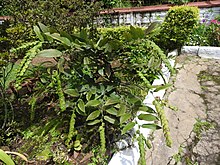
The Faboideae are a subfamily of the flowering plant family Fabaceae or Leguminosae. An acceptable alternative name for the subfamily is Papilionoideae, or Papilionaceae when this group of plants is treated as a family.
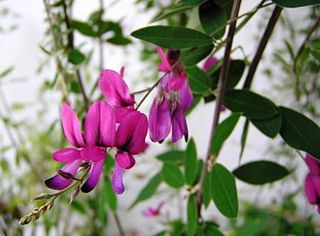
Lespedeza is a genus of some 45 species of flowering plants in the pea family (Fabaceae), commonly known as bush clovers or Japanese clovers (hagi). The genus is native to warm temperate to subtropical regions of eastern North America, eastern and southern Asia and Australasia.

The plant tribe Phaseoleae is one of the subdivisions of the legume subfamily Faboideae, in the unranked NPAAA clade. This group includes many of the beans cultivated for human and animal food, most importantly from the genera Glycine, Phaseolus, and Vigna.

Desmodium is a genus of plants in the legume family Fabaceae, sometimes called tick-trefoil, tick clover, hitch hikers or beggar lice. There are dozens of species and the delimitation of the genus has shifted much over time. Species are distributed widely – from Quebec to northern Argentina in the Americas, across northern and southern tropical Africa, in the southern Arabian Peninsula, in Myanmar and Thailand, New Guinea, and northern and eastern Australia.
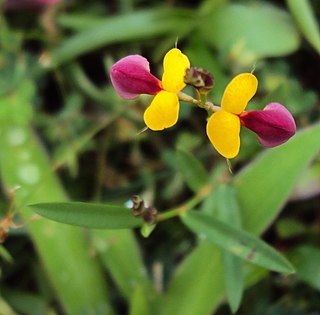
Alysicarpus is a genus of flowering plants in the legume family, Fabaceae. It is distributed in tropical and subtropical regions of Africa, Asia, and Australia. Species are known generally as moneyworts. Unusually for legumes, the leaves are simple.
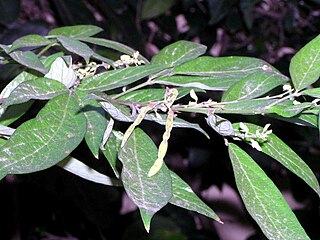
Ohwia caudata, formerly placed in the genus Desmodium, is a deciduous nitrogen fixing plant in the family Fabaceae. It is found in India, China, Taiwan and other parts of Asia. The shrub grows to a height of about 1.5 m tall. It is related to Arthroclianthus, Nephrodesmus and Hanslia. The leaves and roots of the plant are used as an insecticide.
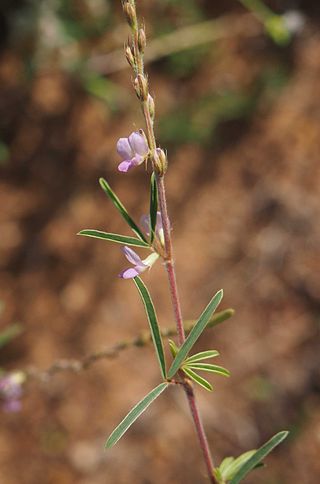
Aphyllodium is a genus of flowering plants in the family Fabaceae. It belongs to the subfamily Faboideae. Members of the genus are found in various parts of Australia, South Asia, Southeastern Asia, and south China.
Arthroclianthus is a genus of flowering plants in the family Fabaceae. It belongs to the subfamily Faboideae. Its 13–19 species are all endemic to New Caledonia. Its closest relatives include Nephrodesmus, also endemic to New Caledonia, Ohwia and Hanslia.

Christia is a genus of flowering plants in the family Fabaceae. It belongs to the subfamily Faboideae.

Dendrolobium is a genus of flowering plants in the legume family, Fabaceae. It belongs to the subfamily Faboideae. It includes 21 species of mostly trees and shrubs and rarely herbs. Species range from eastern Africa to Madagascar, India, Indochina, southern China, Malesia, Papuasia, northern and western Australia, and the southwestern Pacific. Typical habitats include seasonally-dry tropical forest and woodland, bamboo thickets, and grassland.
Desmodiastrum is a genus of flowering plants in the family Fabaceae. It belongs to the subfamily Faboideae and is found in India. The genus includes three species of annuals which are native to India, Myanmar, and Java.

Kummerowia is a genus of flowering plants in the legume family, Fabaceae. It includes two species native to eastern Asia, ranging from the Russian Far East through China and Japan to Vietnam and Laos. The genus belongs to the subfamily Faboideae. These plants were formerly in genus Lespedeza.
Leptodesmia is a genus of flowering plants in the legume family, Fabaceae. It belongs to the subfamily Faboideae. It includes four species ranging from Madagascar and the Comoros to the Indian subcontinent, Indochina, China, Japan, Malesia, New Guinea, and Queensland.
Nephrodesmus is a genus of flowering plants in the legume family, Fabaceae. It belongs to the subfamily Faboideae. It contains four species, all endemic to New Caledonia. Its closest relatives is Arthroclianthus, also endemic to New Caledonia and their distinction has been challenged.

Uraria is a genus of plants in the legume family, Fabaceae. It includes 24 species of shrubs and subshrubs native to sub-Saharan Africa, the Indian Subcontinent, Indochina, China, Malesia, Papuasia, Australia, and the South Pacific. Typical habitats are seasonally-dry tropical woodland or grassland. It belongs to the subfamily Faboideae and the tribe Desmodieae.

The tribe Desmodieae is one of the subdivisions of the plant family Fabaceae. It is composed of two subtribes, Desmodiinae and Lespedezinae. Recent phylogenetics has this tribe nested within tribe Phaseoleae.

Grona is a genus in the flowering plant family Fabaceae. Its native range is worldwide tropics and subtropics.
Verdesmum is a monotypic genus of flowering plants belonging to the family Fabaceae. It only contains one known species, Verdesmum hentyi. It is also within the tribe Desmodieae, with another species Verdesmum menglaense but this was transferred to the Hylodesmum genus in 2019.
